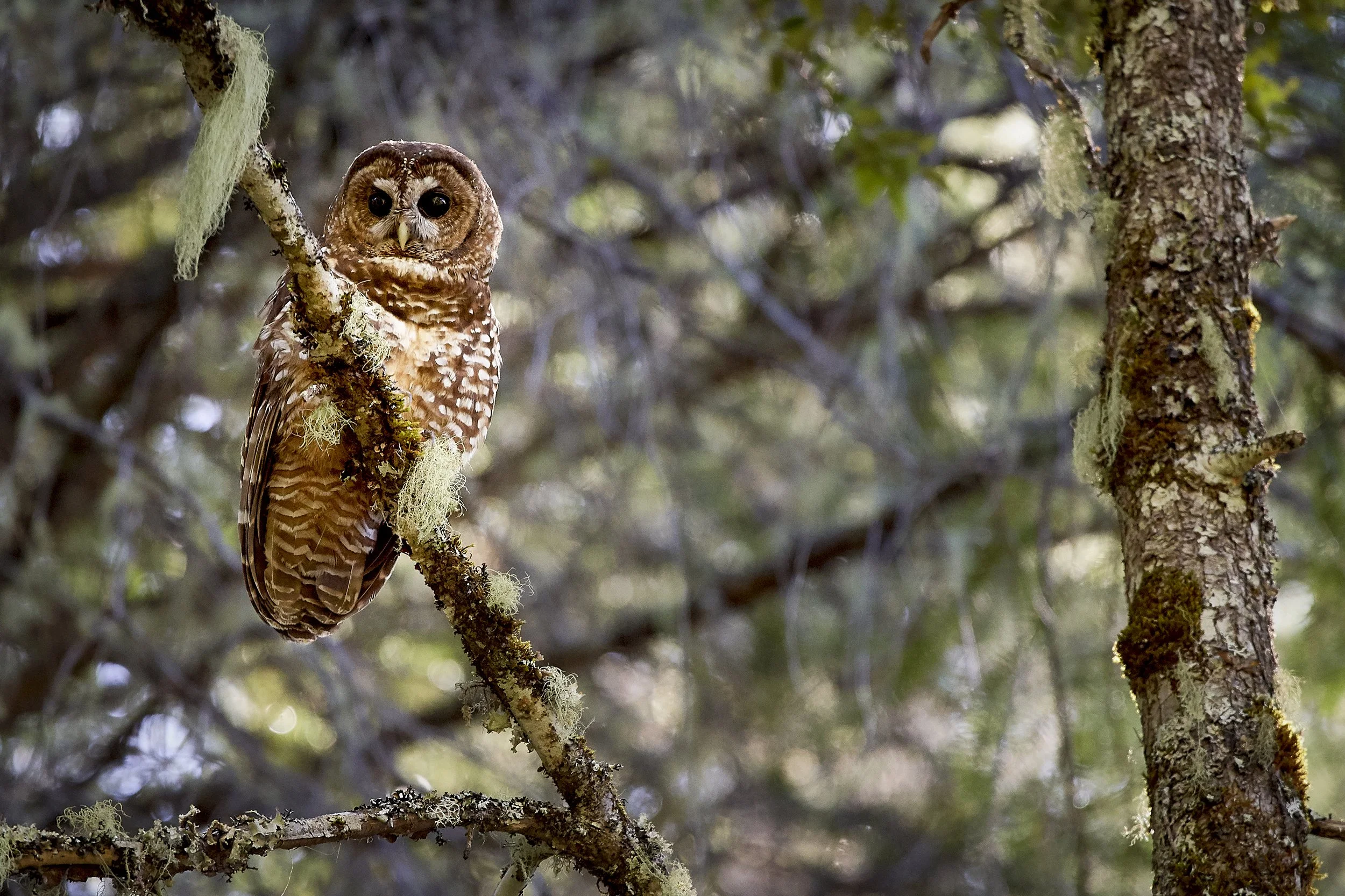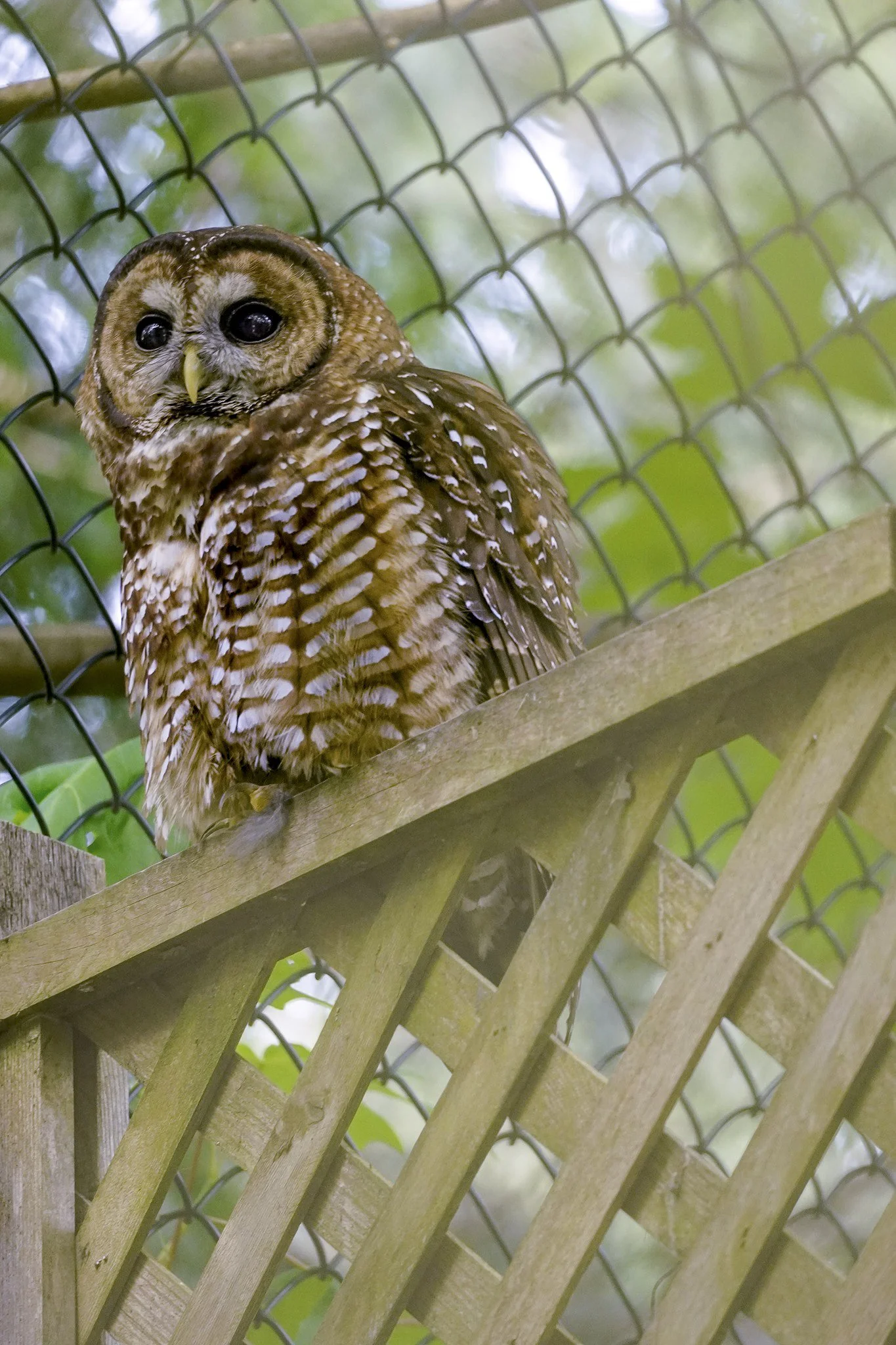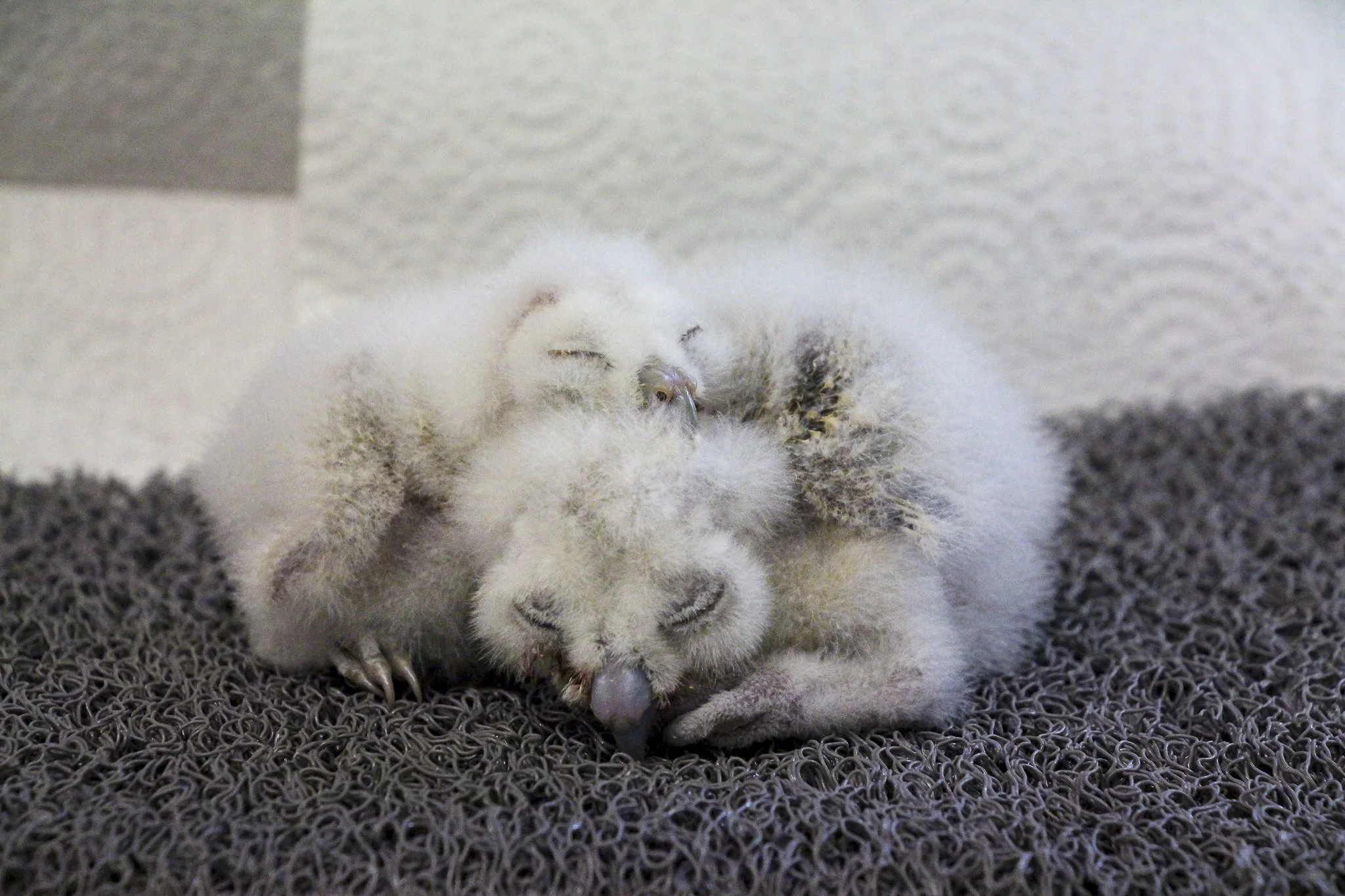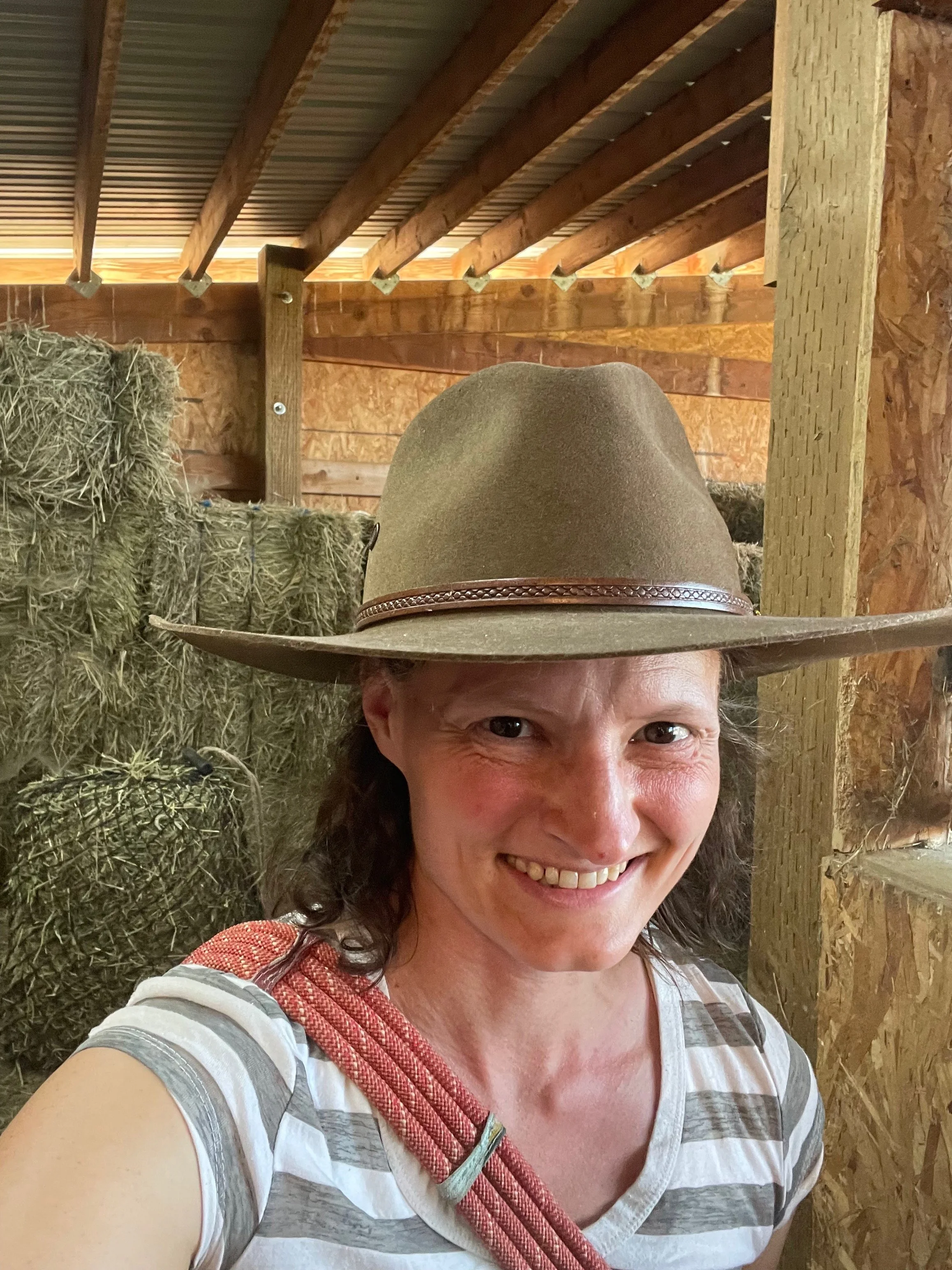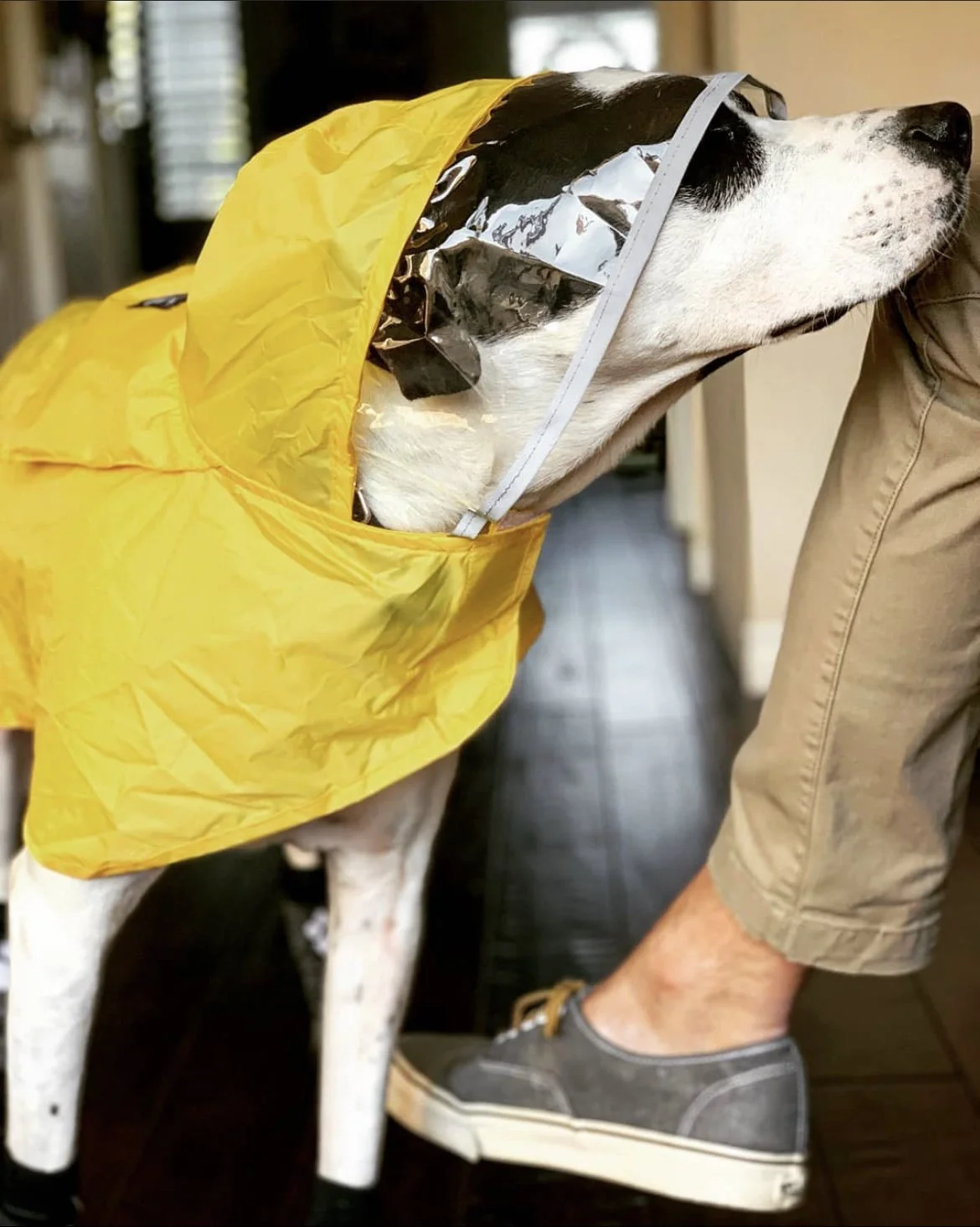Barring the Gates
The life and death struggle of northern spotted owl conservation
A northern spotted owl (Strix occidentalis caurina) watches and waits on a mossy limb in its natural habitat of old growth forest in southern Oregon. The northern spotted owl is facing extinction on multiple fronts, from habitat loss to competition from other owls. The way forward for these creatures is enigmatic. Image credit: Frank D. Lospalluto via Flickr (CC BY-NC-ND 2.0), edits by Rachel Lense for The Science Writer
by Marisa-Claire Mumford
June 21, 2023
The hatchback Prius rocked and bumped through the British Columbia wilderness, slowly navigating around potholes and up a remote logging road. It was 2013, and a field crew was driving through northern spotted owl habitat, though none had been seen there in a generation. The population of northern spotted owls was plummeting, and efforts that would have seemed dramatic decades earlier — like lethally removing competitor raptors or taking the few remaining wild owls into captivity for breeding — suddenly sounded less far-fetched. The Prius stopped. Its doors opened to the fresh, damply cool aroma of a forest hugged with old-growth boughs and dappled with ferns and mosses.
Yoda, a wild-caught juvenile northern spotted owl, is now an integral part of the Northern Spotted Owl Breeding Program. Adding wild-caught owls to a breeding program introduces much-needed genetic diversity to combat unwanted mutations in future generations. Image credit: Northern Spotted Owl Breeding Program
Jasmine McCulligh, then an intern with the nonprofit Northern Spotted Owl Breeding Program in Langley, British Columbia, kept a sharp lookout as they unloaded gear and cued up recordings of owl calls, hoping to draw one in. Spotted owls are territorial, so if an owl heard the acoustic lure, it might approach to defend its territory. A healthy male, whom they later dubbed Yoda in a nod to the Toyota they drove, swooped in to investigate. The researchers caught him with a noose pole, which is a bit like a controlled lasso on a stick. Yoda was banded, fit with a radio transmitter, and sent on his way. Observing an owl in the wild was huge. “Historically, we had about 1,000 spotted owls here” in Southern British Columbia, said McCulligh. “But now we have, like, three.”
The threat of extinction is real. In the fall of 2021, the United States Fish and Wildlife Service, or USFWS, proposed removing 23 species from protection under the Endangered Species Act because they are now presumed extinct. Nearly half of those species were birds. The northern spotted owl, especially in the northernmost portion of its range, now has researchers and government agencies weighing impossible moral decisions, including preserving the life of one species of raptor at the expense of another. In Canada, the situation is even more dire. Yoda, who once fathered chicks in the wild, now lives in captivity, contributing his genes to the next generation through the Northern Spotted Owl Breeding Program, the only such program in the world. How did we get here?
***
Northern spotted owls were officially listed as threatened in the U.S. in 1990, in part because logging diminished their old-growth forest homes. Now, in addition to habitat loss and wildfires, they are further threatened by a seemingly unstoppable wave of invading barred owls.
Originally found only in forests east of the Great Plains, barred owls were first documented in British Columbia in 1943 and began inching south, arriving in Washington state in 1965, Oregon in 1972, and California in 1976. A 2009 USFWS report delved into why these eastern raptors suddenly spread west. Barred owls, like spotted owls, often nest in tree cavities. Great Plains grasslands, which lacked suitable nesting sites, served as a natural barrier to barred owl migration. But as settlers constructed towns, planted trees, and suppressed wildfires over the last century, previously inaccessible plains became paths for westward expansion.
Barred owls’ larger size and more aggressive nature allow them to physically dominate spotted owls, and barred owls can consistently outbreed and outcompete spotted owl neighbors for resources, according to a 2014 study led by J. David Wiens, a supervisory research wildlife biologist with the U.S. Geological Survey. When they have a mate and good territory, depending on food availability and weather patterns, wild spotted owl pairs don’t necessarily raise young every year. Spotted owls that lose territory often survive, but without an established nest and the safety and food that territory confers, they fail to reproduce, said Wiens.
A large adult barred owl (Strix varia) perches on the snowy branch of a conifer tree in winter. Barred owls have encroached on northern spotted owl territory in the last several decades and are outcompeting them in many ways, adding to the existential pressure the northern spotted owls now face. Image Credit: Rodney Campbell via Flickr (CC 2.0 BY-ND)
Barred owls, on the other hand, are more likely to adapt if their preferred nesting locations aren’t available. They attempt to make homes in all sorts of places, leading to further reproductive success. Wiens and colleagues observed them producing up to 4.4 times more offspring than spotted owls over three years, and they occupied land at three to eight times higher density than spotted owls. In regions where spotted owl numbers are already low from habitat loss, added stress from territory competition makes population recovery unlikely, according to Wiens.
And it’s not just spotted owls that are affected by the influx of barred owls. When a balanced ecosystem is hit with more predators, prey is seriously impacted as well. Spotted owls are picky eaters, preferentially eating flying squirrels. They also eat deer mice, shrews, voles, woodrats, and rabbits. Barred owls consume all of the small nocturnal mammals spotted owls do, but they also predate practically anything that moves, including moles, reptiles, fish, amphibians, smaller birds, and arthropods. There are even reports of barred owls eating worms, slugs, and poisonous newts. This undiscriminating appetite allows for adaptation to a variety of landscapes. Barred owls are “having really heavy impacts on a lot of other native species besides the spotted owl, so I think that's a really important component of what's going on,” said Wiens. “They're ferocious predators, for sure.”
Barred owls have likely moved into habitats faster than prey could adapt, potentially triggering a trophic cascade — an ecosystem-wide shift. Like ripples in a pond, one change affects the entire system. Say barred owls take over a spotted owl territory and over-predate flying squirrels. Flying squirrels eat and subsequently spread spores from ectomycorrhizal mushrooms. Ectomycorrhizals form beneficial relationships with trees by stabilizing root systems, protecting against pathogens and drought, and delivering essential nutrients and minerals. These fungi also store carbon and support soil biodiversity. Ultimately, overhunting one prey species can change the health of the whole forest.
Spotted owls cannot maintain ecosystem balance if they continue to decrease in number and lose territory. So why not just move the barred owls to a non-old-growth forest where they won’t bother the spotted owls? Relocation, or soft removal, was attempted in British Columbia beginning in 2007, but owls returned on numerous occasions. One particularly persistent barred owl in British Columbia was recaptured three times from the same site. As barred owl numbers continue rising, straightforward options for aiding spotted owls are becoming scarce.
***
Wiens recently led a team investigating whether lethal removal of barred owls improved spotted owl survival. Working in Washington, Oregon, and California, the team assessed five paired treatment and control areas over a three-to-six-year period. Where barred owls were killed, spotted owl populations remained stable, Wiens’ group reported in 2021. However, in areas without intervention, spotted owl numbers declined at a rate of 12.1% per year.
One treatment area included territory where two spotted owls had lived for 10 consecutive years. “A lot of folks had grown attached to this pair of birds over the years, and barred owls had come in and displaced them,” said Wiens. After two years of barred owl removal in the area, he said, the pair returned and even generated offspring.
The approach works, yet it’s difficult to garner public support for the lethal removal of raptors, even if they are non-native. Most people aren’t used to seeing 12-gauge shotguns listed in the “materials and methods” sections of scientific papers. It's more comfortable to be pro-conservation if death is not part of the package. Like spotted owls, most raptor species are struggling under the stresses of development, habitat loss, pollution, and climate change, according to a 2018 analysis. Barred owls are among the minority of raptors — 9% worldwide — that are succeeding and seeing population increases. Creation is imbued with variety and diversity, and “adapt or die” has proven to be the law of the land.
When researching the efficacy of lethal removal, scientists eliminate barred owls only from very specific sites identified as spotted owl habitat. The quantity of barred owls removed thus far has not made a significant dent in their population or success as a species, and the birds that are sacrificed do not go to waste. Their bodies are sent all over the country — donated to veterinary schools, museums, and universities, where they contribute to scientists’ understanding of diet, parasite load, genetic background, environmental contamination, and wing and feather aerodynamics.
The USFWS is carefully developing a barred owl management strategy that is expected to come out this fall, said Wiens. Since barred owls are moving down the West Coast, removal efforts continue in California where spotted owls still have a foothold. In the Sierra Nevada mountains, barred owls don’t yet have well-established territories, so they can be killed as they enter. “In Oregon or Washington, where things are pretty dire for spotted owls, I’m not seeing a lot of action,” said Wiens. “In fact, there’s none.” While acoustic monitoring is ongoing, no barred owl removal has occurred in Washington or Oregon since 2019.
Though spotted owl numbers continue to fall, there’s not likely to be any help in the near future. There is currently no funding mechanism for implementing any sort of barred owl management plan, said Wiens, and barred owls’ population and tenacity are such that managing them will require a long-term commitment. Additionally, barred owls are federally protected in the U.S. under the Migratory Bird Treaty Act. They can only be taken with special research permits, so specific exceptions must be created to remove them legally.
By the time a plan is approved and funded, there’s a chance that, at least in some areas, there won’t be any owls left to protect. Will the public support defending forests from barred owls and logging if there aren’t any spotted owls? Ultimately, population supplementation may be the way forward.
***
At the breeding center, Yoda currently is successfully paired with Georgia, an owl with a different genetic background, but progress is slow. Northern spotted owls preferentially bond for life. While some pairs breed the first year, others can take up to five years to successfully mate. In captivity, where food is endlessly available, pairs are “double-clutched” to increase the number of offspring in the shortest time possible. Eggs are removed, and chicks are hand-reared for the first 10 days, triggering the owls to lay a second set of eggs and raise more young than they’d be able to in nature. “Seeing the heartbeat on an egg for the first time is incredible,” said McCulligh, now facility coordinator at the breeding program. “You realize that you have this life in your hands.”
Fledgelings Georgia and Fraser hatched in captivity as part of the Northern Spotted Owl Breeding Program in British Columbia in the spring of 2019. Image credit: Northern Spotted Owl Breeding Program
The program plans to support a wild Canadian population of around 250 owls, but with seven chicks fledging per year at best, it’s a long road. Last August, 15 years after the breeding program opened, the first release of three male northern spotted owls occurred. The owls were placed in an area where barred owls had been removed and where there was a known female. One of the males was injured, presumably by a train, and brought back to the program for recuperation. The two remaining released owls and the wild female are the only known non-captive spotted owls in all of Canada.
If spotted owls are to stay in Washington and Oregon, Wiens said, they may exist much like their Canadian counterparts: in a handful of carefully selected, defensible reserves where barred owls are kept out, spotted owls are carefully monitored, and the population is supplemented through captive breeding. Though no breeding program exists in the U.S., our neighbors to the north have done the bulk of the heavy lifting and can advise should we wish to move in that direction.
Human activity likely set the stage for spotted owl decline. It seems only natural that we feel a certain degree of responsibility to reverse the damage. But the hard reality is that, even with a good arsenal, it just may not be possible this late in the game. “I think time is running out,” said Wiens. “It's a very narrow window of opportunity that we have to make a difference, and it's closing quick.”
Post-Script: Since the story was written, two owls released in the wild have died. Sadly, only one spotted owl remains in Canada.
Marisa-Claire Mumford
Marisa-Claire “MC” Mumford is a Pacific Northwest-based medical writer with a background in preclinical drug discovery and an interdisciplinary bachelor’s degree in biochemistry, biophysics, and molecular biology from Whitman College. She is a current student in the science writing master’s program at Johns Hopkins University. When she isn’t immersed in data and research, MC is either outside camping, hiking, kayaking, and cross-country skiing, or inside baking, learning linocut, and playing the piano.
Senior Editor: William Kucinski
Art Editor: Rachel Lense
Copy Editor: Colin O'Connor

